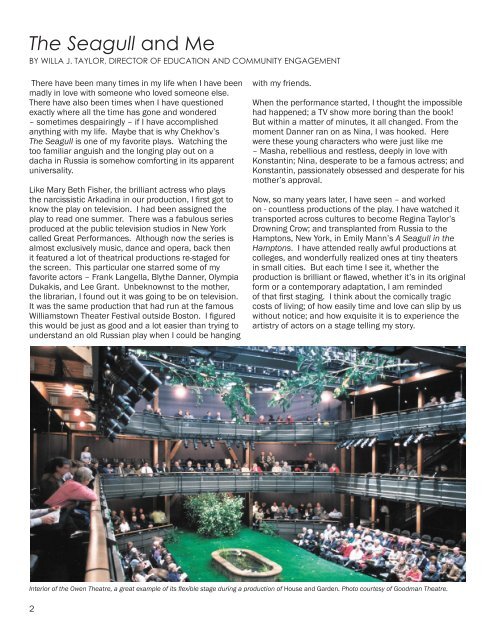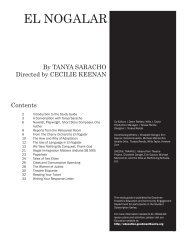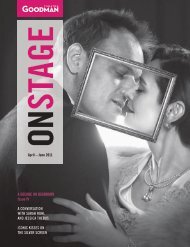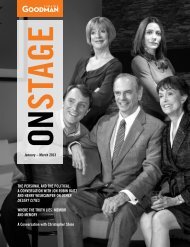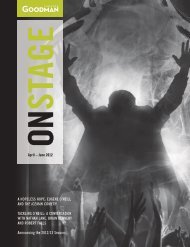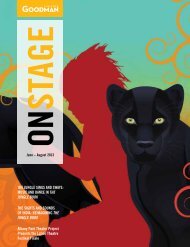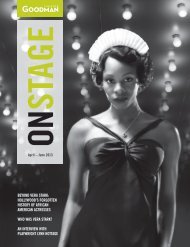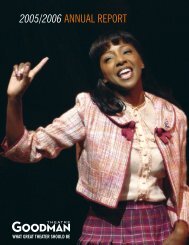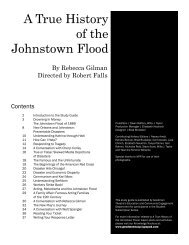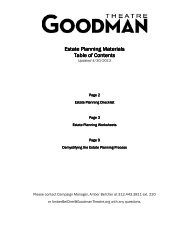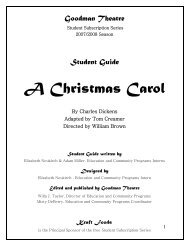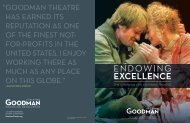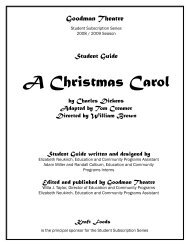The Seagull Study Guide (12MB) - Goodman Theatre
The Seagull Study Guide (12MB) - Goodman Theatre
The Seagull Study Guide (12MB) - Goodman Theatre
Create successful ePaper yourself
Turn your PDF publications into a flip-book with our unique Google optimized e-Paper software.
<strong>The</strong> <strong>Seagull</strong> and Me<br />
BY WILLA J. TAYLOR, DIRECTOR OF EDUCATION AND COMMUNITY ENGAGEMENT<br />
<strong>The</strong>re have been many times in my life when I have been<br />
madly in love with someone who loved someone else.<br />
<strong>The</strong>re have also been times when I have questioned<br />
exactly where all the time has gone and wondered<br />
– sometimes despairingly – if I have accomplished<br />
anything with my life. Maybe that is why Chekhov’s<br />
<strong>The</strong> <strong>Seagull</strong> is one of my favorite plays. Watching the<br />
too familiar anguish and the longing play out on a<br />
dacha in Russia is somehow comforting in its apparent<br />
universality.<br />
Like Mary Beth Fisher, the brilliant actress who plays<br />
the narcissistic Arkadina in our production, I first got to<br />
know the play on television. I had been assigned the<br />
play to read one summer. <strong>The</strong>re was a fabulous series<br />
produced at the public television studios in New York<br />
called Great Performances. Although now the series is<br />
almost exclusively music, dance and opera, back then<br />
it featured a lot of theatrical productions re-staged for<br />
the screen. This particular one starred some of my<br />
favorite actors – Frank Langella, Blythe Danner, Olympia<br />
Dukakis, and Lee Grant. Unbeknownst to the mother,<br />
the librarian, I found out it was going to be on television.<br />
It was the same production that had run at the famous<br />
Williamstown <strong>The</strong>ater Festival outside Boston. I figured<br />
this would be just as good and a lot easier than trying to<br />
understand an old Russian play when I could be hanging<br />
with my friends.<br />
When the performance started, I thought the impossible<br />
had happened; a TV show more boring than the book!<br />
But within a matter of minutes, it all changed. From the<br />
moment Danner ran on as Nina, I was hooked. Here<br />
were these young characters who were just like me<br />
– Masha, rebellious and restless, deeply in love with<br />
Konstantin; Nina, desperate to be a famous actress; and<br />
Konstantin, passionately obsessed and desperate for his<br />
mother’s approval.<br />
Now, so many years later, I have seen – and worked<br />
on - countless productions of the play. I have watched it<br />
transported across cultures to become Regina Taylor’s<br />
Drowning Crow; and transplanted from Russia to the<br />
Hamptons, New York, in Emily Mann’s A <strong>Seagull</strong> in the<br />
Hamptons. I have attended really awful productions at<br />
colleges, and wonderfully realized ones at tiny theaters<br />
in small cities. But each time I see it, whether the<br />
production is brilliant or flawed, whether it’s in its original<br />
form or a contemporary adaptation, I am reminded<br />
of that first staging. I think about the comically tragic<br />
costs of living; of how easily time and love can slip by us<br />
without notice; and how exquisite it is to experience the<br />
artistry of actors on a stage telling my story.<br />
Interior of the Owen <strong>The</strong>atre, a great example of its flexible stage during a production of House and Garden. Photo courtesy of <strong>Goodman</strong> <strong>The</strong>atre.<br />
2


